Abstract
Experimental estimates of the premelting Adenine-Thymine base pair opening probability for some B-DNA sequences are two orders of magnitude smaller than those of other B-DNA sequences. The AT pairs in the sequence with smaller open probability seem to be those that have a well defined spine of hydration in the minor groove. We show that this spine of hydration can significantly enhance the thermal stability of the base pairs to which they are attached. The effect of this spine of hydration coupled with the possible stabilization effect contributed from neighboring GC pairs can explain the differences in the observed AT pair opening probability for different AT containing B-DNA sequences.
Full text
PDF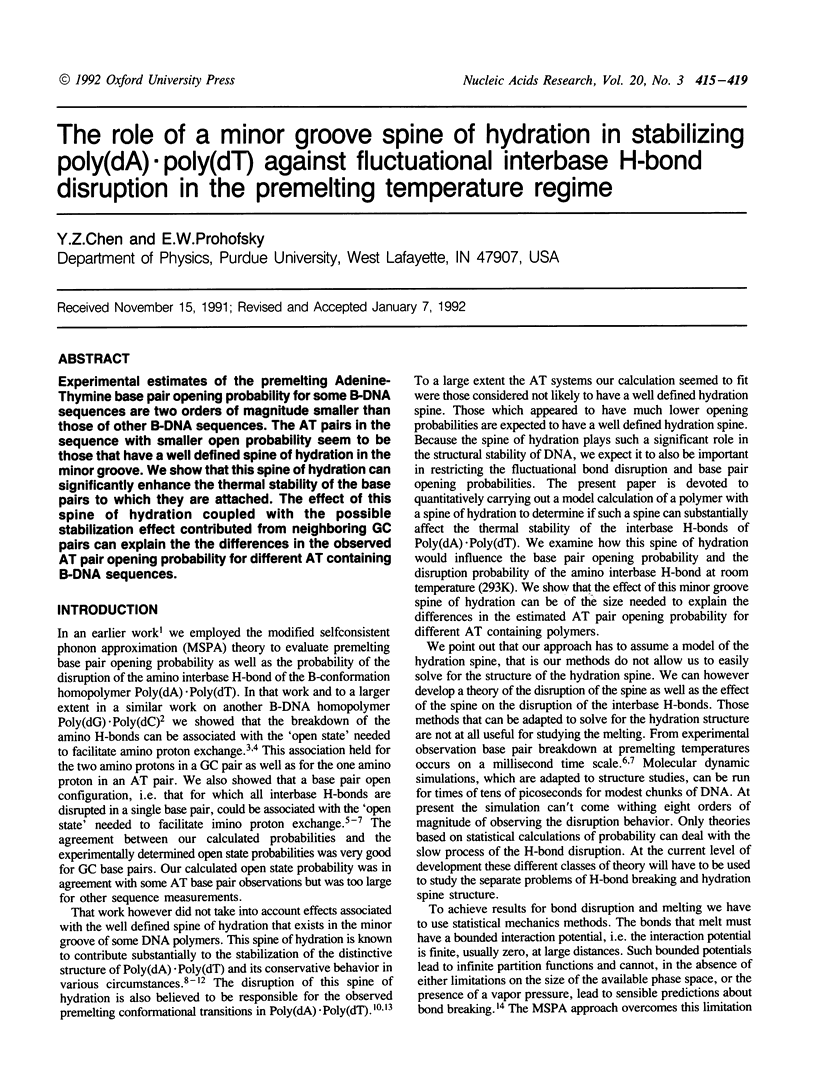
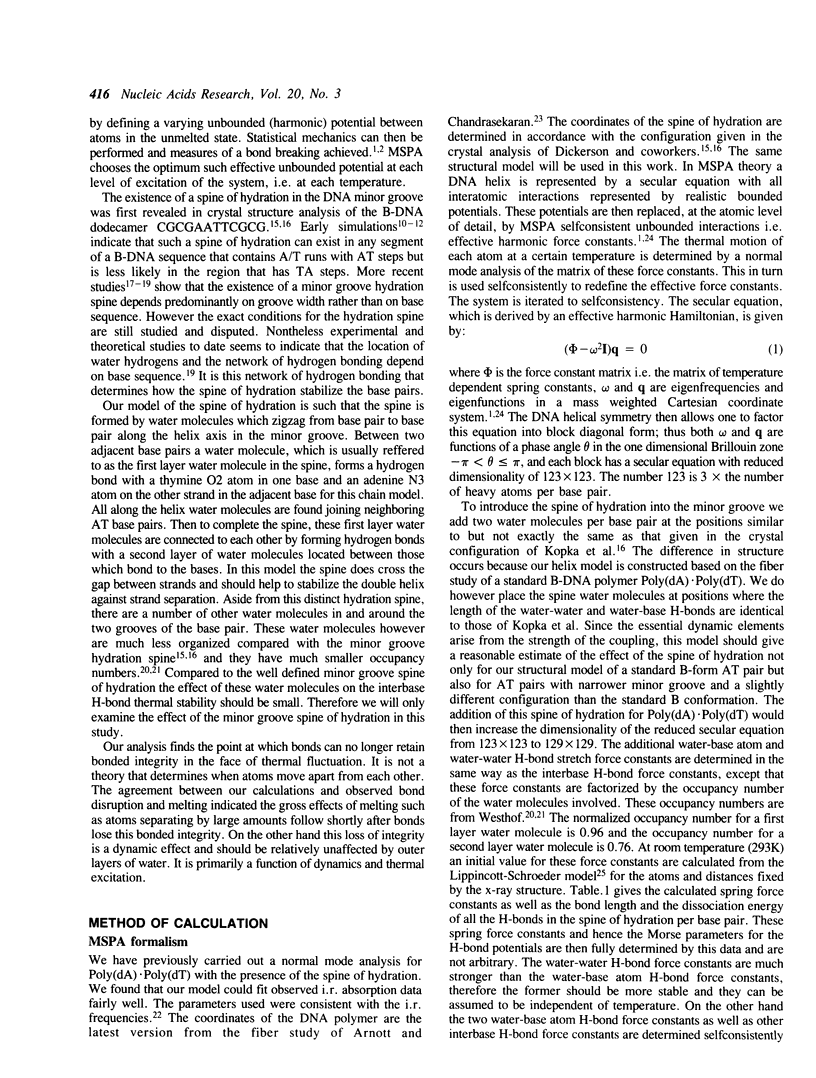
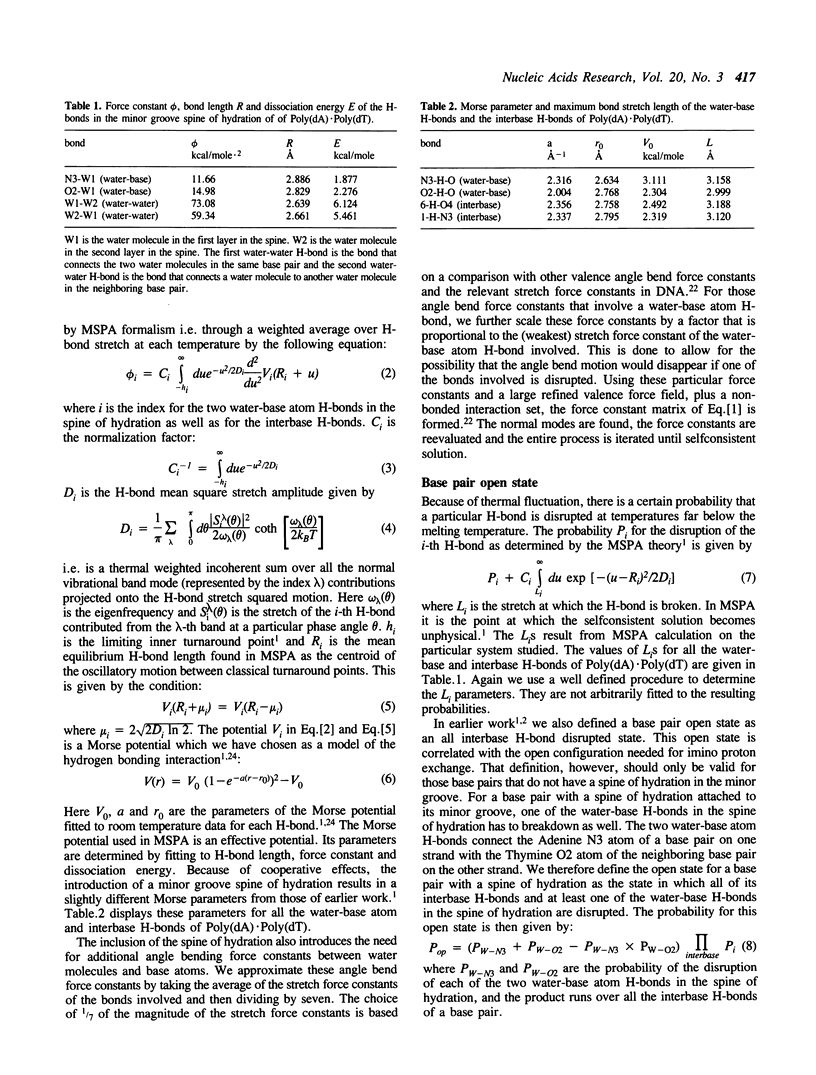
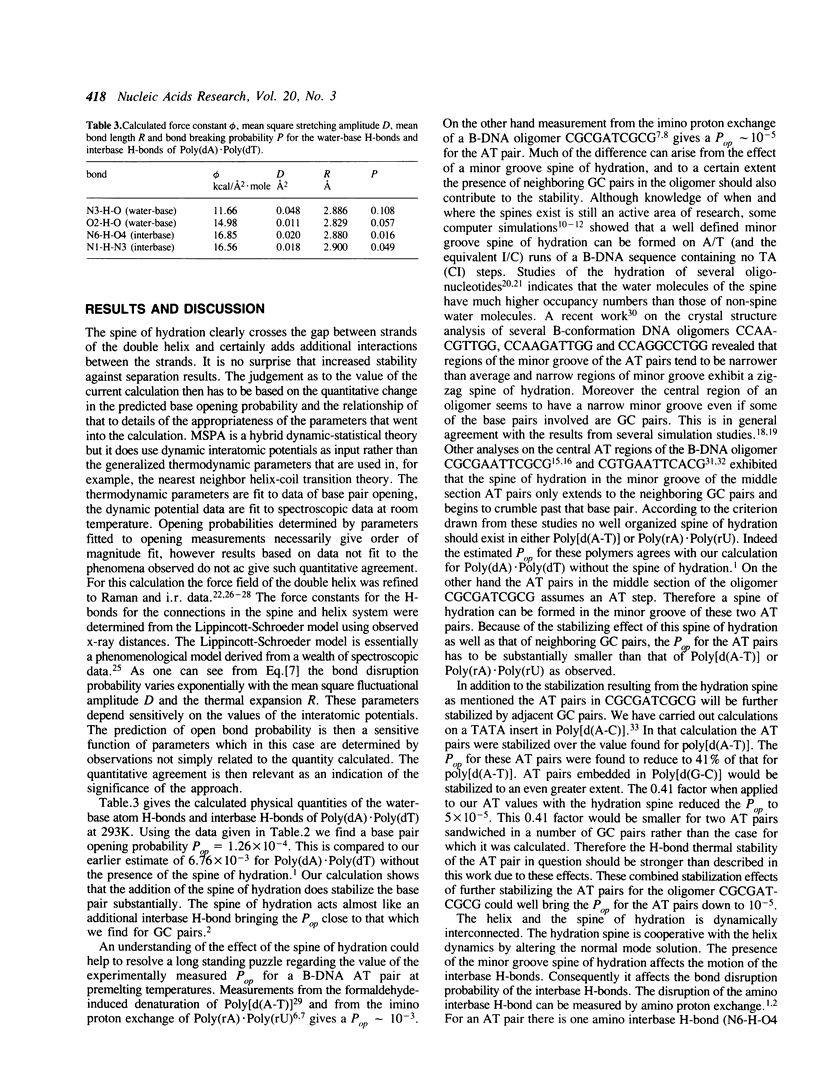
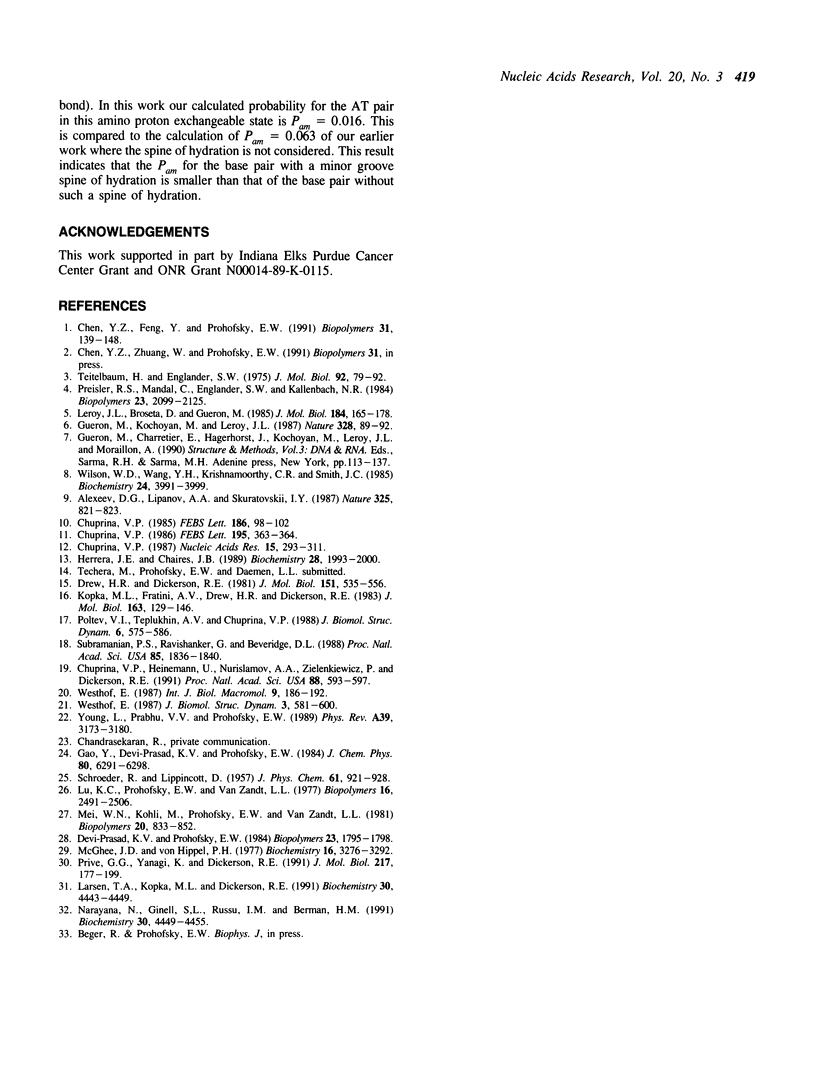
Selected References
These references are in PubMed. This may not be the complete list of references from this article.
- Alexeev D. G., Lipanov A. A., Skuratovskii IYa Poly(dA).poly(dT) is a B-type double helix with a distinctively narrow minor groove. 1987 Feb 26-Mar 4Nature. 325(6107):821–823. doi: 10.1038/325821a0. [DOI] [PubMed] [Google Scholar]
- Chen Y. Z., Feng Y., Prohofsky E. W. Premelting thermal fluctuational base pair opening probability of poly(dA).poly(dT) as predicted by the modified self-consistent phonon theory. Biopolymers. 1991 Feb 5;31(2):139–148. doi: 10.1002/bip.360310202. [DOI] [PubMed] [Google Scholar]
- Chuprina V. P. Anomalous structure and properties of poly (dA).poly(dT). Computer simulation of the polynucleotide structure with the spine of hydration in the minor groove. Nucleic Acids Res. 1987 Jan 12;15(1):293–311. doi: 10.1093/nar/15.1.293. [DOI] [PMC free article] [PubMed] [Google Scholar]
- Chuprina V. P., Heinemann U., Nurislamov A. A., Zielenkiewicz P., Dickerson R. E., Saenger W. Molecular dynamics simulation of the hydration shell of a B-DNA decamer reveals two main types of minor-groove hydration depending on groove width. Proc Natl Acad Sci U S A. 1991 Jan 15;88(2):593–597. doi: 10.1073/pnas.88.2.593. [DOI] [PMC free article] [PubMed] [Google Scholar]
- Chuprina V. P. Regularities in formation of the spine of hydration in the DNA minor groove and its influence on the DNA structure. FEBS Lett. 1985 Jul 1;186(1):98–102. doi: 10.1016/0014-5793(85)81347-8. [DOI] [PubMed] [Google Scholar]
- Devi Prasad K. V., Prohofsky E. W. Low-frequency lattice mode predictions in A-DNA compared to experimental observations and significance for A-to-B conformation change. Biopolymers. 1984 Sep;23(9):1795–1798. doi: 10.1002/bip.360230912. [DOI] [PubMed] [Google Scholar]
- Drew H. R., Dickerson R. E. Structure of a B-DNA dodecamer. III. Geometry of hydration. J Mol Biol. 1981 Sep 25;151(3):535–556. doi: 10.1016/0022-2836(81)90009-7. [DOI] [PubMed] [Google Scholar]
- Guéron M., Kochoyan M., Leroy J. L. A single mode of DNA base-pair opening drives imino proton exchange. Nature. 1987 Jul 2;328(6125):89–92. doi: 10.1038/328089a0. [DOI] [PubMed] [Google Scholar]
- Herrera J. E., Chaires J. B. A premelting conformational transition in poly(dA)-Poly(dT) coupled to daunomycin binding. Biochemistry. 1989 Mar 7;28(5):1993–2000. doi: 10.1021/bi00431a006. [DOI] [PubMed] [Google Scholar]
- Kopka M. L., Fratini A. V., Drew H. R., Dickerson R. E. Ordered water structure around a B-DNA dodecamer. A quantitative study. J Mol Biol. 1983 Jan 5;163(1):129–146. doi: 10.1016/0022-2836(83)90033-5. [DOI] [PubMed] [Google Scholar]
- Larsen T. A., Kopka M. L., Dickerson R. E. Crystal structure analysis of the B-DNA dodecamer CGTGAATTCACG. Biochemistry. 1991 May 7;30(18):4443–4449. doi: 10.1021/bi00232a010. [DOI] [PubMed] [Google Scholar]
- Leroy J. L., Broseta D., Guéron M. Proton exchange and base-pair kinetics of poly(rA).poly(rU) and poly(rI).poly(rC). J Mol Biol. 1985 Jul 5;184(1):165–178. doi: 10.1016/0022-2836(85)90050-6. [DOI] [PubMed] [Google Scholar]
- Lu K. C., Prohofsky E. W., Van Zandt L. L. Vibrational modes of A-DNA, B-DNA, and A-RNA backbones: an application of a green-function refinement procedure. Biopolymers. 1977 Nov;16(11):2491–2506. doi: 10.1002/bip.1977.360161112. [DOI] [PubMed] [Google Scholar]
- McGhee J. D., von Hippel P. H. Formaldehyde as a probe of DNA structure. r. Mechanism of the initial reaction of Formaldehyde with DNA. Biochemistry. 1977 Jul 26;16(15):3276–3293. doi: 10.1021/bi00634a002. [DOI] [PubMed] [Google Scholar]
- Narayana N., Ginell S. L., Russu I. M., Berman H. M. Crystal and molecular structure of a DNA fragment: d(CGTGAATTCACG). Biochemistry. 1991 May 7;30(18):4449–4455. doi: 10.1021/bi00232a011. [DOI] [PubMed] [Google Scholar]
- Poltev V. I., Teplukhin A. V., Chuprina V. P. Monte-Carlo simulation of DNA duplex hydration. B and B' conformations of poly(dA).poly(dT) have different hydration shells. J Biomol Struct Dyn. 1988 Dec;6(3):575–586. doi: 10.1080/07391102.1988.10506508. [DOI] [PubMed] [Google Scholar]
- Preisler R. S., Mandal C., Englander S. W., Kallenbach N. R., Frazier J., Miles H. T., Howard F. B. Premelting and the hydrogen-exchange open state in synthetic RNA duplexes. Biopolymers. 1984 Nov;23(11 Pt 1):2099–2125. doi: 10.1002/bip.360231102. [DOI] [PubMed] [Google Scholar]
- Privé G. G., Yanagi K., Dickerson R. E. Structure of the B-DNA decamer C-C-A-A-C-G-T-T-G-G and comparison with isomorphous decamers C-C-A-A-G-A-T-T-G-G and C-C-A-G-G-C-C-T-G-G. J Mol Biol. 1991 Jan 5;217(1):177–199. doi: 10.1016/0022-2836(91)90619-h. [DOI] [PubMed] [Google Scholar]
- Subramanian P. S., Ravishanker G., Beveridge D. L. Theoretical considerations on the "spine of hydration" in the minor groove of d(CGCGAATTCGCG).d(GCGCTTAAGCGC): Monte Carlo computer simulation. Proc Natl Acad Sci U S A. 1988 Mar;85(6):1836–1840. doi: 10.1073/pnas.85.6.1836. [DOI] [PMC free article] [PubMed] [Google Scholar]
- Teitelbaum H., Englander S. W. Open states in native polynucleotides. II. Hydrogen-exchange study of cytosine-containing double helices. J Mol Biol. 1975 Feb 15;92(1):79–92. doi: 10.1016/0022-2836(75)90092-3. [DOI] [PubMed] [Google Scholar]
- Westhof E. Re-refinement of the B-dodecamer d(CGCGAATTCGCG) with a comparative analysis of the solvent in it and in the Z-hexamer d(5BrCG5BrCG5BrCG). J Biomol Struct Dyn. 1987 Dec;5(3):581–600. doi: 10.1080/07391102.1987.10506414. [DOI] [PubMed] [Google Scholar]
- Wilson W. D., Wang Y. H., Krishnamoorthy C. R., Smith J. C. Poly(dA).poly(dT) exists in an unusual conformation under physiological conditions: propidium binding to poly(dA).poly(dT) and poly[d(A-T)].poly[d(A-T)]. Biochemistry. 1985 Jul 16;24(15):3991–3999. doi: 10.1021/bi00336a029. [DOI] [PubMed] [Google Scholar]
- Young L, Prabhu VV, Prohofsky EW. Calculation of far-infrared absorption in polymer DNA. Phys Rev A Gen Phys. 1989 Mar 15;39(6):3173–3180. doi: 10.1103/physreva.39.3173. [DOI] [PubMed] [Google Scholar]


